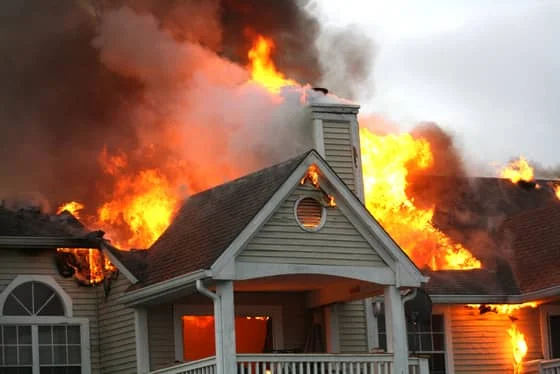Fires that cause damage to a home but do not totally destroy it present unique insurance claim problems, specifically in the realm of partial loss house fire claims.
Because the house has only been partially demolished, these claims are frequently referred to as “partial losses.” Consider these strategic tips to maximize your reimbursement from partial loss house fire claims saving you from the potential stress and hassle of selling a fire-damaged house.
The fundamentals you need to know
In any property loss scenario, including partial loss house fire claims, there are fundamental procedures to follow that can help speed up the insurance recovery process.
First, video or photograph everything that was damaged or destroyed. Then, submit your claim in a timely manner.
You should also become familiar with insurance terminology, assert your right to full and equitable compensation, and seek assistance as needed.
Who should examine the damage?
You should be sure to rely on authorized and skilled experts. Structural engineers and contractors are trained to assess damage (as well as the structural soundness of your roof/remaining beams, etc.) and determine the cost of repairs.
The best person to test the air quality is a Certified Industrial Hygienist. It is rarely adequate to have a major loss assessed solely by your insurance company’s chosen adjuster.
In addition to the adjuster’s inspection, qualified professionals are usually required. Ask again in writing and respectfully remind your insurance of their legal need to properly investigate all damage, including hidden damage, if they refuse to conduct or pay for adequate inspections.
If a dispute arises, it’s worthwhile to locate and pay for your own inspection by a reliable, impartial expert.
How thorough should the inspection be?
It should be very thorough whether you are planning to restore your property or thinking of selling a fire-damaged house. A complete examination will include coverage of all of the following:
Roof:
It is important to check your roof for ember damage. Extreme heat could damage the roof’s structural integrity. Mold and water stains on the wood beneath the roof are also possible. A roofing professional can confirm damage.
Structural steel and iron:
Steel and iron constructions have the potential to conduct heat, which could weaken a foundation or retaining wall.
Concrete, siding, and stucco:
Heating can cause stucco to spall and crack. After being exposed to heat, siding may melt, and there may be mold underneath. In addition, heat may also harm an anchored foundation or footing. That’s why a structural engineer should be brought in to examine the property.
Windows:
Due to heat, window frames may melt, blister, or change color. Warping, staining, and a reduction in the transparency of glass are all possible. Mold issues and/or moisture issues might result from warped windows as well.
Plumbing and heating systems:
Check for damage to pipes, solder/connectors, and ducts.
Interior walls/framing:
A contractor might open up walls for a thorough inspection of your home. This process aims to uncover any framing damage or detect harmful mold. By doing so, they actively assess the condition and ensure the structural integrity and safety of your living space.
Matching New & Old Materials
Remember, it is preferable to discover damage as soon as possible to make sure your home is restored to a “uniform and consistent” appearance rather than a “patchwork quilt” of mismatched new and old materials.
Also keep in mind that if an insurer agrees to match something like new siding on the exterior walls of my home to the old siding you may have recourse.
In most states and under most policies, you are entitled to compensation for the cost of bringing your home’s exterior and interior appearances back to “uniform and consistent” standards.
Make sure there is a clear and unequivocal exclusion in your policy (and confirm whether that exclusion is legal) before you accept it if you have only a partial loss and your insurer won’t pay to match paint colors, roof tile materials, carpets, or any other visible materials.
Also, before accepting no as a response, seek assistance from your state’s insurance department, a qualified claim or legal professional.
Will insurance pay to cover mold removal?
The answer is “maybe.” Many new property insurance policies now exclude mold damage. Whether these exclusions apply depends on the damage and the specific wording of your insurance contract.
One thing to note: even if there is a mold exclusion in your policy, cleanup, fans, and other drying techniques are likely covered. If your insurer refuses to pay for cleaning and drying, leading to mold development, the full damage may still be covered despite the mold exclusion.
Remember that attempts to suppress the fire may have exposed your home’s structure to the elements or allowed mold to grow inside your walls.
Mold grows notoriously easily on wet walls.
That is why you must inspect, dry, and repair the house’s interior and exterior drywall and the underlying wood.
What about cleaning up smoke and ash?
In handling partial loss house fire claims, it’s crucial to include smoke damage, a covered peril under most homeowners insurance policies, due to its potential to harm porous materials like textiles, rugs, curtains, and unpainted wood, either temporarily or permanently.
You may clean some items, but others will need replacement. For instance, tile and marble can discolor.
Most likely, your insurance company will cover the cost of cleaning smoke and ash, although disagreements frequently occur over whether to clean or replace goods that have been exposed to smoke.
What about trees and plants?

The majority of plants will die in extreme heat and smoke, and they may contaminate the soil, making replanting challenging.
In managing partial loss house fire claims, it’s important to remember that damaged plants might not immediately perish. Keeping your claim active for at least six months allows you to observe the full extent of the damage and submit additional claims as needed for damaged foliage. Typically, a fixed sum or a portion of your dwelling coverage amount can be applied to cover the expense of replacing landscaping, ensuring that both structural and environmental damages are comprehensively addressed.
However, landscape losses frequently exceed coverage limitations. For example, mature trees can be worth up to $5,000, while many plans have a per-tree limit of just $500.
Sell Your Fire Damaged House
Has your home suffered fire damage? If so, you may want to sell it to We Buy Fire Damaged Houses instead of going through an expensive and lengthy repair process.
At We Buy Fire Damaged Houses we pay all cash and buy burned in as-is condition.
You can learn much more by filling out and submitting the form below.
Photo by Look Up Look Down Photography on Unsplash

